 Backend Development
Backend Development PHP Tutorial
PHP Tutorial Tutorial: Use Xiaomi push extension to implement message push function in PHP application
Tutorial: Use Xiaomi push extension to implement message push function in PHP applicationTutorial: Use Xiaomi push extension to implement message push function in PHP applications
Introduction:
With the development of mobile Internet, message push has become one of the indispensable functions in modern applications. one. Xiaomi push is a widely used message push service that can send push notifications to Android devices. This tutorial will introduce how to use Xiaomi push extension in PHP applications to implement message push function.
Step 1: Apply for Xiaomi developer account and application
First, you need to register an account on the Xiaomi developer website, log in and create an application. When creating an application, you will get an AppSecret, which will be used later.
Step 2: Install Xiaomi Push Extension
In order to use Xiaomi Push in PHP applications, we need to install an extension package. Use the following command to install the extension pack:
composer require xmpush/xmpush
Step 3: Initialize Xiaomi Push
Before starting, we need to introduce the namespace of Xiaomi Push and initialize the instance of Xiaomi Push. You can refer to the following code:
require_once 'vendor/autoload.php';
use xmpushBuilder;
use xmpushConstants;
use xmpushSender;
use xmpushStats;
use xmpushTracer;
// 初始化Xiaomi推送实例
Constants::setPackage('<Android应用的包名>');
Constants::setSecret('<AppSecret>');
Step 4: Build the message push content
Before sending the push notification, we need to build the push message content. You can customize the message content according to your own application needs. Here is an example:
$message = new Builder();
$message->title('<推送标题>');
$message->description('<推送详细内容>');
$message->passThrough(0);
$message->notifyType(1);Step 5: Send Push Notification
Once the message content is constructed, we can send the push notification. You can use the send method of the Sender class to specify parameters such as the push target and message content. The following is an example:
$sender = new Sender(); $result = $sender->sendToAlias($message, '<设备别名>');
Where, <device alias></device> is the alias of the device that receives the push notification. It can be the alias of a single device, or a list of device aliases.
Step 6: Process push results
After sending the push notification, we can get the push result through the $result object. The following is an example:
if ($result->getErrorCode() == Constants::SUCCESS) {
echo "推送成功!";
} else {
echo "推送失败:" . $result->getReason();
}Step 7: Handle the event when the user clicks the push notification
When the user clicks the push notification, we can handle the corresponding event by setting the click behavior. The following is an example:
$message->extra('key', 'value');In this example, we set the key to "key" and the value to "value". When the user clicks on the push notification, we can obtain the key-value pair and process it accordingly.
Conclusion:
Through this tutorial, we learned how to use the Xiaomi push extension to implement the message push function in PHP applications. Now, you can use Xiaomi Push in your app to send push notifications to Android devices. Hope this tutorial helps you!
The above is the detailed content of Tutorial: Use Xiaomi push extension to implement message push function in PHP application. For more information, please follow other related articles on the PHP Chinese website!
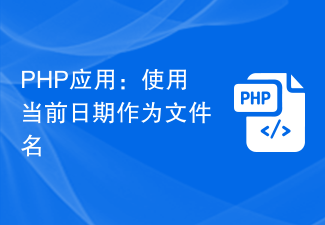 PHP应用:使用当前日期作为文件名Jun 20, 2023 am 09:33 AM
PHP应用:使用当前日期作为文件名Jun 20, 2023 am 09:33 AM在PHP应用中,我们有时需要使用当前日期作为文件名来保存或上传文件。虽然可以手动输入日期,但使用当前日期作为文件名可以更方便、快捷和准确。在PHP中,我们可以使用date()函数来获取当前日期。该函数的使用方法为:date(format,timestamp);其中,format为日期格式字符串,timestamp为表示日期和时间的时间戳,不传递该参数将使用
 教程:使用Firebase Cloud Messaging在PHP应用中实现定时消息推送功能Jul 25, 2023 am 11:21 AM
教程:使用Firebase Cloud Messaging在PHP应用中实现定时消息推送功能Jul 25, 2023 am 11:21 AM教程:使用FirebaseCloudMessaging在PHP应用中实现定时消息推送功能概述FirebaseCloudMessaging(FCM)是谷歌提供的一种免费的消息推送服务,它能够帮助开发者向Android、iOS和Web应用发送实时消息。本教程将带领大家通过PHP应用使用FCM实现定时消息推送功能。步骤一:创建Firebase项目首先,在F
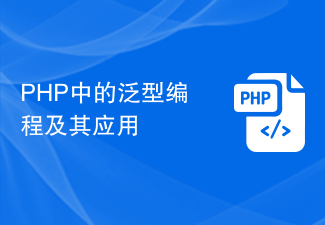 PHP中的泛型编程及其应用Jun 22, 2023 pm 08:07 PM
PHP中的泛型编程及其应用Jun 22, 2023 pm 08:07 PM一、什么是泛型编程泛型编程是指在编程语言中实现一种通用的数据类型,使得这种数据类型能够适用于不同的数据类型,从而实现代码的复用和高效。PHP是一种动态类型语言,不像C++、Java等语言有强类型机制,因此在PHP中实现泛型编程不是一件容易的事情。二、PHP中的泛型编程方式PHP中有两种方式实现泛型编程:分别是使用接口和使用Trait。使用接口在PHP中创建一
 Redis在PHP应用中的正则表达式操作May 16, 2023 pm 05:31 PM
Redis在PHP应用中的正则表达式操作May 16, 2023 pm 05:31 PMRedis是一个高性能的key-value存储系统,它支持多种数据结构,其中包括字符串、哈希表、列表、集合、有序集合等。同时,Redis也支持对字符串数据进行正则表达式的匹配和替换操作,这使得它在开发PHP应用中具有很大的灵活性和便捷性。在PHP应用中使用Redis进行正则表达式操作,需要先安装好phpredis扩展,该扩展提供了与Redis服务器进行通信的
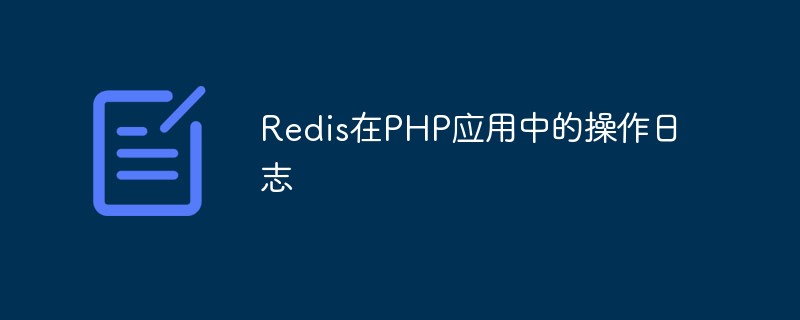 Redis在PHP应用中的操作日志May 15, 2023 pm 08:10 PM
Redis在PHP应用中的操作日志May 15, 2023 pm 08:10 PMRedis在PHP应用中的操作日志在PHP应用中,使用Redis作为缓存或存储数据的方案已经变得越来越普遍了。Redis是一种高性能的键值存储数据库,具有快速、可扩展、高可用、数据结构多样等特点。在使用Redis时,为了更好地了解应用程序的运行情况,同时为了数据的安全性,我们需要有一份Redis操作日志。Redis操作日志能够记录Redis服务器上所有客户端
 Redis在PHP应用中的全文搜索May 19, 2023 am 08:01 AM
Redis在PHP应用中的全文搜索May 19, 2023 am 08:01 AM随着互联网技术的不断发展,搜索引擎的应用越来越广泛。在互联网的背景下,搜索引擎已成为用户获取信息的主要途径之一。而在此过程中,全文搜索技术起到了至关重要的作用。全文搜索通过对文本内容的建立索引,在用户查询时快速定位到匹配的文本。在PHP应用中实现全文搜索,有很多的方案,而本文将重点介绍Redis在PHP应用中的全文搜索。Redis是一个高性能的非关系型内存
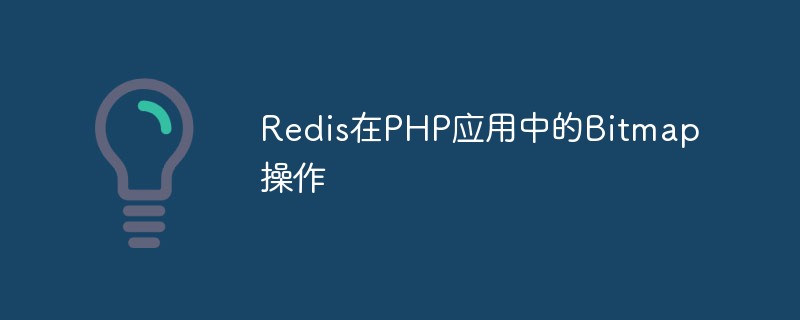 Redis在PHP应用中的Bitmap操作May 19, 2023 am 08:10 AM
Redis在PHP应用中的Bitmap操作May 19, 2023 am 08:10 AM在Web开发领域,Redis是一个非常流行的键值存储数据库,而PHP是一种广泛使用的Web编程语言。Redis提供了许多功能,其中一个非常有用的功能是Bitmap操作。Bitmap是Redis中的一种数据结构,它可以轻松地实现各种位图操作。本文旨在介绍Redis中的Bitmap操作,并演示如何在PHP中使用这些操作。什么是Bitmap?Bitmap是一种数据
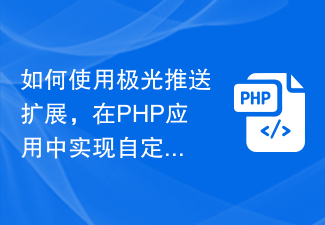 如何使用极光推送扩展,在PHP应用中实现自定义消息推送样式和声音Jul 24, 2023 pm 06:33 PM
如何使用极光推送扩展,在PHP应用中实现自定义消息推送样式和声音Jul 24, 2023 pm 06:33 PM如何使用极光推送扩展,在PHP应用中实现自定义消息推送样式和声音引言:在移动应用开发中,消息推送是必不可少的功能之一。极光推送作为目前较为常用的推送平台之一,提供了丰富的功能来满足开发者的需求。本文将介绍如何使用极光推送扩展,在PHP应用中实现自定义消息推送样式和声音的功能。一、了解极光推送扩展极光推送扩展(JPush)是一款基于PHP语言开发的推送SDK,


Hot AI Tools

Undresser.AI Undress
AI-powered app for creating realistic nude photos

AI Clothes Remover
Online AI tool for removing clothes from photos.

Undress AI Tool
Undress images for free

Clothoff.io
AI clothes remover

AI Hentai Generator
Generate AI Hentai for free.

Hot Article

Hot Tools

Notepad++7.3.1
Easy-to-use and free code editor

Atom editor mac version download
The most popular open source editor

Dreamweaver Mac version
Visual web development tools

Dreamweaver CS6
Visual web development tools

DVWA
Damn Vulnerable Web App (DVWA) is a PHP/MySQL web application that is very vulnerable. Its main goals are to be an aid for security professionals to test their skills and tools in a legal environment, to help web developers better understand the process of securing web applications, and to help teachers/students teach/learn in a classroom environment Web application security. The goal of DVWA is to practice some of the most common web vulnerabilities through a simple and straightforward interface, with varying degrees of difficulty. Please note that this software





